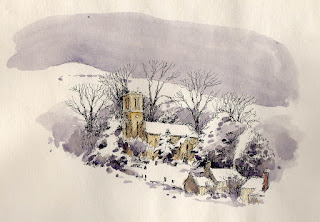Well, at this time of year we’re supposed to see some snow, but the only time I’ve come across the white stuff this winter is on the high mountains, so last week I did encounter brilliant snow effects in the Brecon Beacons, accompanied by the most divine light flooding the western face of Cribin. Alas, I’d left my paintbox in my Viper haversack and the resulting sketch done with watersoluble pencil failed to capture the amazing colours, and I was too high up to make a quick dash for the car.
So here I will show you a pen and wash sketch I did of New Radnor church many years ago in beautiful snow conditions.
This was done in an A4 cartridge book with limited colours. Everything is cool, except the yellow ochre on the buildings. In a painting I would simplify the scene, as the cottages compete with the church, which is the main centre of attention. I’d probably put these cottages into shadow, making them quite dark to throw the emphasis on the church caught in strong sunlight.
Christmas was a happy, but wild affair of tearing round Kent, Sussex and Hampshire to see various members of the family. Still, I was able to relax at times with a riveting novel set in the French Alps around Chamonix, Running Water & The Guide, by A E W Mason, himself an Alpinist active in the early 20th century. It has been brought to life again by Professor Roberta Grandi with an excellent scholarly introduction and notes on Mason’s life and career. I thoroughly enjoyed the plot and recommend it whole-heartedly. The cover shows my watercolour of the Brenva Ridge and the misty slopes of Mont Blanc. It’s available on Amazon.
The sun is beckoning me out, so I will leave you with the hope that 2022 will be a great year for you all, after all the problems of Covid, and I wish you much happy painting!






